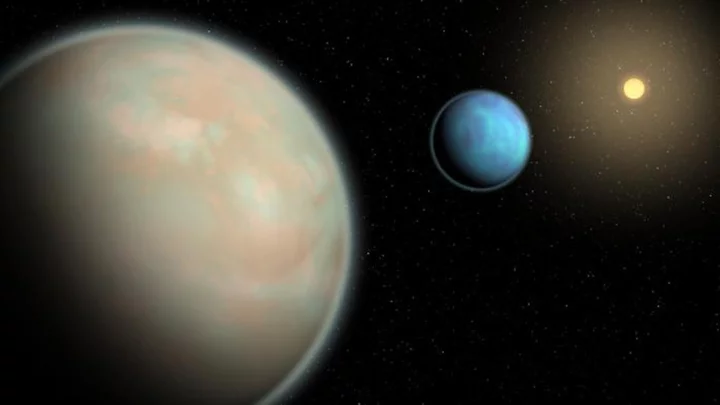
Scientists find six planet system where stars orbit in rhythmic beat
Astronomers have found a planetary system with six different worlds that orbit in a strange rhythm. The set of planets move around their star in a rhythmic beat, scientists say, staying synchronised in a kind of dance. The findings could help shed more light on how planets form and evolve, the researchers say. The star is smaller, and slightly dimmer than the Sun, and the six “sub-Neptunes” - possibly smaller versions of Neptune in our solar system - move in a cyclic rhythm. According to the experts, this orbital waltz repeats itself so precisely it can be readily set to music. The star, HD110067, is 100 light-years away in the northern constellation of Coma Berenices, and had perplexed researchers for years. Now scientists, including those at the University of Warwick, have revealed the true architecture of this unusual system using Nasa and European Space Agency (Esa) spacecraft. The analysis was led by University of Chicago scientist Dr Rafael Luque, who said: “This discovery is going to become a benchmark system to study how sub-Neptunes, the most common type of planets outside of the solar system, form, evolve, what are they made of, and if they possess the right conditions to support the existence of liquid water in their surfaces.” The first indication of planets orbiting the strange star system came in 2020, when Nasa’s Transiting Exoplanet Survey Satellite (Tess) detected dips in the star’s brightness which suggested planets were passing in between the star and the spacecraft. A preliminary analysis revealed two possible planets - one with a year (the length of time it takes to complete one orbit around the star) of 5.64 days, and another with an unknown period at the time. Two years later, Tess observed the same star again, and analysis ruled out the original interpretation but presented two additional possible planets. Much was still unknown about the planetary system, until scientists across the world - including those at the University of Warwick - joined the investigation. They used data from Esa’s Characterising Exoplanet Satellite (Cheops), hoping to determine the orbital periods of these faraway planets. While multi-planet systems are common in the Milky Way, those in a tight gravitational formation known as “resonance” are observed by astronomers far less often. In this case, the planet closest to the star makes three orbits for every two of the next planet out - called a 3/2 resonance - a pattern that is repeated among the four closest planets. Among the outermost planets, a pattern of four orbits for every three of the next planet out (a 4/3 resonance) is repeated twice. Thomas Wilson, from the Department of Physics at the University of Warwick, said: “By establishing this pattern of planet orbits, we were able to predict other orbits of planets we hadn’t yet detected. “From this we lined up previously unexplained dips in starlight observed by Cheops and discovered three additional planets with longer orbits. This was only possible with the crucial Cheops data.” Researchers say the planets - two to three times the size of Earth - are likely to have been performing this same rhythmic dance since the system formed billions of years ago. Dr Luque said: “We think only about 1% of all systems stay in resonance, and even fewer show a chain of planets in such configuration.” Experts say orbitally resonant systems are extremely important to find because they tell astronomers about the formation and subsequent evolution of the planetary system. Planets around stars tend to form in resonance but can easily have their orbits thrown around. For example, a very massive planet, a close encounter with a passing star, or a giant impact event can all disrupt the careful balance. Therefore, multi-planet systems preserving their resonance are rare. HD110067 is the brightest known system with four or more planets. Since those planets are all sub-Neptune-sized with likely larger atmospheres, it makes them ideal candidates for studying using the James Webb Space Telescope (JWST) and the Esa’s future Ariel telescope. Mr Wilson added: “All of these planets have large atmospheres - similar to Uranus or Neptune - which makes them perfect for observation with JWST. “It would be fascinating to test if these planets are rocky like Earth or Venus but with larger atmospheres - solid surfaces potentially with water. “However, they are all much hotter than Earth - 170C to 530C - which would make it very difficult for life to exist.” Hannah Osborne, a PhD student at UCL’s Mullard Space Science Laboratory and a co-author of the study, said: “The system itself is a key discovery for exoplanet science: because all six planets are in a resonant chain we know that the architecture of the system can’t have changed much since its formation, so by studying HD110067 we get a rare window into the past to understand how these types of systems may have formed and evolved.” The findings are published in the Nature journal. Additional reporting by Press Association Read More Astronomers find unprecedented ‘disc’ around distant planet Astronomers discover new six-planet system Scientists have cooked ‘alien haze’ that could help find life Astronomers find unprecedented ‘disc’ around distant planet Astronomers discover new six-planet system Scientists have cooked ‘alien haze’ that could help find life
2023-11-30 00:15

One trillion tonne iceberg escapes from Antartica and is gaining speed
The world’s biggest iceberg is drifting away from the Antarctic after having been grounded there for more than 30 years. The iceberg, which has the catchy name A23a, split from the Antarctic’s giant Filchner Ice Shelf in 1986, but has been stuck to the ocean floor since shortly after that time. Now, according to the British Antarctic Survey, it is on the move. Satellite images show the iceberg drifting past the northern tip of the Antarctic Peninsula. A23a is truly massive. It weighs nearly a trillion metric tonnes and is about three times the size of New York City. It is more than twice the size of Greater London. Scientists say the massive chunk of ice is drifting at a rate of three miles each day. “Over time, it’s probably just thinned slightly and got that little bit of extra buoyancy that’s allowed it to lift off the ocean floor and get pushed by ocean currents,” said Oliver Marsh, a glaciologist at the British Antarctic Survey. Andrew Fleming, a remote sensing expert from the British Antarctic Survey, told the BBC the iceberg had been drifting for the last year, but now appeared to be picking up speed. “I asked a couple of colleagues about this, wondering if there was any possible change in shelf water temperatures that might have provoked it, but the consensus is the time had just come,” he said. Still, some scientists are concerned about how the movement could affect wildlife. The iceberg could end up at the island of South Georgia, which is about 1,000 miles east of the southern tip of South America, which is home to seals, penguins and other seabirds. Chad Greene, a glaciologist at NASA’s Jet Propulsion Laboratory, told the New Scientist large icebergs tend to break off from Antarctica around once per decade. They then get stuck in the Antarctic’s nearly freezing waters, which staves off the melting process, but only for a while. “Icebergs this big can hang around for decades in one place, then one day decide to go for a jolly,” Greene said. “That’s when things get interesting.” How to join the indy100's free WhatsApp channel Sign up to our free indy100 weekly newsletter Have your say in our news democracy. Click the upvote icon at the top of the page to help raise this article through the indy100 rankings.
2023-11-29 22:23

How to see your Spotify Wrapped for 2023?
It's almost that time of year again, when we see how many hours we've shamelessly spent listening to mortifying music and just playing Taylor Swift on loop. Yes, Spotify Wrapped is here again and soon your social media feeds will be full of people either showing you how cool by how much Senegalese lounge Jazz they listen to or embarrassed that they still haven't moved on from The Libertines or The Strokes. Each and every year, even for the most dedicated of music lovers, Spotify Wrapped throws up countless surprises in your top artists and songs leading many to question just how it tallies what you listen to. The past few years Wrapped has arrived earlier and earlier, as reported by the Radio Times, so it's not surprise that its arrived on November 29th. Here are the dates it arrived on the previous years. 2017: 6th December 2018: 6th December 2019: 5th December 2020: 2nd December 2021: 1st December 2022: 30th November Finding your Wrapped couldn't be easier you just need to go to your Spotify app on the day it drops and it'll be there waiting for you at the top of the app alongside your saved songs and albums. Alternatively, if you just use Spotify on a laptop or desktop you can visit spotify.com/wrapped and use it from there. Spotify have never officially said how they compile their data for Wrapped but a Reddit user in 2021 revealed how they believed it works. In the post Hudsonlovestech pointed out six key takeaways that they discovered after downloading their data from the music platform. They were: This year the data was logged from January 1st 00:00 to November 15th 23:59. You have to listen to a song for more than 30 seconds for it to count in your song rankings. Your top songs are calculated by play count rather than total time listened. In your top 100 playlist only the first 10 songs are sorted by play count, the rest are close but sorted by artist. Your total time listening includes podcasts. Your top artists are calculated by total play counts rather than total time listening. If you apply this date to your own listening history then there is a chance you might discover what your Wrapped will look like this year although there is no guarantee. Meanwhile, many users on X/Twitter are posting memes, imagining what their Wrapped will look like this year. To be honest, we're just dreading seeing how much we listened to Ryan Gosling sing 'I'm Just Ken' from the Barbie soundtrack. Sign up to our free indy100 weekly newsletter Have your say in our news democracy. Click the upvote icon at the top of the page to help raise this article through the indy100 rankings.
2023-11-29 21:58

Scientists cook ‘alien haze’ that could help us find extraterrestrial life
Scientists have cooked up the "alien haze" of distant planets, in an effort to help with the search for alien life. The haze is a simulation of the hazy skies that appear on water-rich exoplanets, or worlds outside of our solar system. That haziness can get in the way of observations of those planets, making it difficult to understand what is happening there. Haze can also affect conditions on the planet themselves. If the atmosphere has hazes or other particles then it can drastically change the temperature, amount of light an other factors – some of which might be make or break for alien life there. Scientists hope the homemade haze will let them better understand the atmospheres of other planets, and model how the planets themselves form and grow. They could allow us to better understand how the have distorts our picture of those planets – distortions that could give us the wrong understanding of the makeup of their atmospheres. Getting that wrong could mean potentially missing habitable worlds, for instance. The observations are used to come up with the estimates about the temperature and atmospheric conditions that are then used to determine whether a planet might be able to host alien life. “The big picture is whether there is life outside the solar system, but trying to answer that kind of question requires really detailed modeling of all different types, specifically in planets with lots of water,” said co-author Sarah Hörst, from Johns Hopkins University. “This has been a huge challenge because we just don't have the lab work to do that, so we are trying to use these new lab techniques to get more out of the data that we’re taking in with all these big fancy telescopes.” The team cooked up the haze using a custom-designed chamber in Hörst’s lab. The haze they made is formed out solid particles, suspended in gas, which changes how light interacts with the gas itself. To test the hazes they made, scientists shot ultraviolet light through them, measuring how much they absorbed and reflected. They found that hate haze matched the chemical signatures of a well-studied exoplanet. Scientists hope to develop yet more hazes, with different gas mixtures, that will let them better understand different atmospheres. The work is described in a new paper, 'Optical properties of organic haze analogues in water-rich exoplanet atmospheres observable with JWST', published in the journal Nature Astronomy. Read More SpaceX rockets are punching holes in atmosphere, causing blood-red ‘auroras’ Chinese rocket that slammed onto Moon may have carried mysterious undisclosed payload Nasa’s ‘Message in a Bottle’ will send your name into space
2023-11-29 21:52

How AI Can Help Clean Up the Biggest Climate Messes
Artificial intelligence is now on the agenda as world leaders, climate diplomats and thousands of others descend on
2023-11-29 21:24

HSBC, SocGen Drop Bids to Get CO2 Goals Approved by UN Body
HSBC Holdings Plc and Societe Generale SA are among banks that have withdrawn applications to get their climate
2023-11-29 21:16

Electric-Car Makers Can Stop Worrying So Much About Lithium
Lithium’s price slump over the past year has been as dramatic as its climb — and it’s probably
2023-11-29 20:59

Tesla Color Wraps May Save the Cybertruck From Its Weird Self
Tesla Inc. designed its stainless-steel Cybertuck to be something special: the first vehicle for the masses that doesn’t
2023-11-29 20:56

GTA 6 fans convinced Rockstar post has just confirmed game's setting
At this point, the setting of Grand Theft Auto 6 isn't up for debate. It'd be a huge shock to see Rockstar Games swerve the much rumoured Vice City, Florida setting. Of course, there's been no official confirmation of the game's setting or any further details as fans await a hotly-anticipated trailer in early December, but a number of big leaks have pointed directly to GTA 6 following up on Grand Theft Auto: Vice City with a trip to the Sunshine State. With only 'unofficial' signs pointing to Vice City, fans have taken a recent post from Rockstar Games as a pre-trailer confirmation that the GTA series is heading back to Florida, and that the map will be based around Vice City. An X account, GTA 6 Trailer Countdown, posted a capture of a Rockstar Games with the following message: "Rockstar Games just dropped some merch including “IVC” sticker and Vice City-themed socks ahead of the GTA 6 reveal in December." This has lead to speculation that Rockstar have all but 'confirmed' Vice City as the setting of the game. However, some fans aren't convinced that the merch drop means anything at all: For now, it seems like all signs point towards a Vice City comeback judging on the leaks that have already occurred, and a return that should be announced very soon. In the meantime, you can pick up your Vice City merch here. Sign up to our free indy100 weekly newsletter Have your say in our news democracy. Click the upvote icon at the top of the page to help raise this article through the indy100 rankings.
2023-11-29 20:55

Taskmaster VR in development as Channel 4 show gets video game twist
'Taskmaster' is expanding beyond Channel 4 with a new virtual reality game turning fans into contestants.
2023-11-29 20:26

Dubai Firm’s Africa Ambitions Raises Carbon Colonialism Concerns
COP28 Daily Reports: Sign up for the Green Daily newsletter for comprehensive coverage of the climate summit right
2023-11-29 19:45

Adobe to defend Figma deal at Dec. 8 EU hearing, sources say
By Foo Yun Chee BRUSSELS Adobe will aim to counter EU antitrust charges that its proposed $20 billion
2023-11-29 19:26
